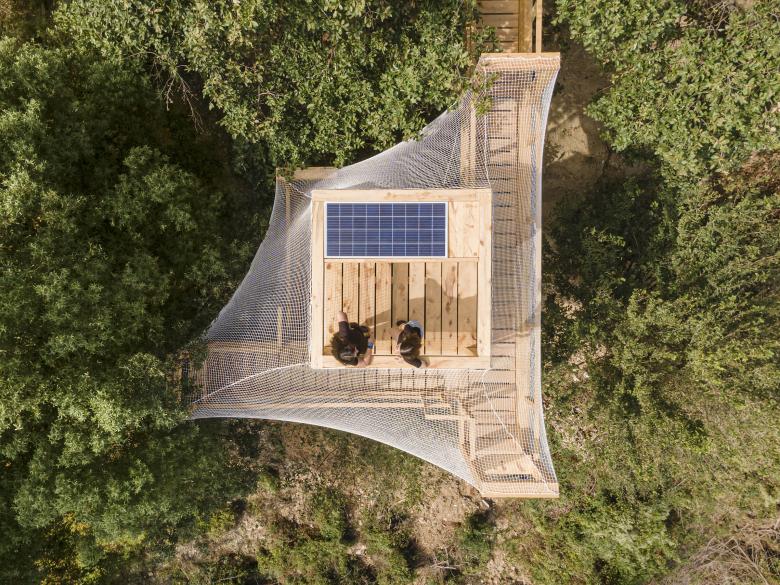A project recently designed and built by graduate students at the Institute for Advanced Architecture of Catalonia (IAAC) in Barcelona is called FLORA, or Forest Lab for Observational Research and Analysis, and it enables researchers to observe the forest canopy of Collserola Natural Park.
Students in IAAC's Master in Advanced Ecological Buildings and Biocities (MAEBB) postgraduate program carry out their design, research, and building efforts at Valldaura Labs in the mountainous Collserola forest. In the case of FLORA, that setting pointed to the program of the building — a research station for observing the biodiversity of the forest canopy and the impact of climate change upon it — as well its construction: It is made primarily from invasive pine trees that were selectively removed from the forest. Covered in a stretched netting that recalls the work of SO–IL, the wood structure will eventually be shrouded by plants, allowing the researchers inhabiting it to better observe the surrounding habitat unobtrusively. Take a visual tour through FLORA below, with further information on the project provided in the captions.
See also:
- "Building with Earth in Barcelona" (on TOVA, a 3D-printed, zero-waste housing prototype)
- “A Quarantine Cabin Made from Zero-Kilometer Wood” (on The Voxel, a self-sufficient cabin made from on-site timber)
Direction: Vicente Guallart and Daniel Ibañez
Developed by the students of the Masters program in Advanced Ecological Buildings and Biocities (MAEBB), 2021/22 class: Andrea Paola Rubio Paredes, Leif-Andres Vallecillo Riksheim, Lillian Wanjiru Beauttah, Pablo Rafael Herraiz García de Guadiana, Prachi Agarwal, Rachael Margaret Verdugo Pelaez, Romain Jacques Kenny Russe, Roshni Chirag Shah, Shagun Modi, Zani Kerubo Gichuki, Iletutu "Tutu" Ibiyemi Awosika, Kshitij Ramlal Sarote, Mónica Irene Pérez Rivera, Prasidh Choudhary, Agnieszka Szklarczyk, Pongpol Punjawaytegul, Suwapat Rodprasert, Anton Hofstadt
Host: Valldaura Labs. Institute for Advanced Architecture of Catalonia
Valldaura Labs Management: Laia Pifarré
Assisted by: Bruno Ganem, Alex Hadley, Gustavo Escudero
Advised by: Marziah Zad, Miquel Rodriguez, Elena Orte, Guillermo Sevillano, Ignasi Caus, Miguel Nevado
Sponsors: Tallfusta, Alberch, Heco Schrauben Ibérica
With the support of: Cerdanyola del Vallès City Council
Volunteer: Marilia Fernandez Lockwood, Philipp Wienkämper













